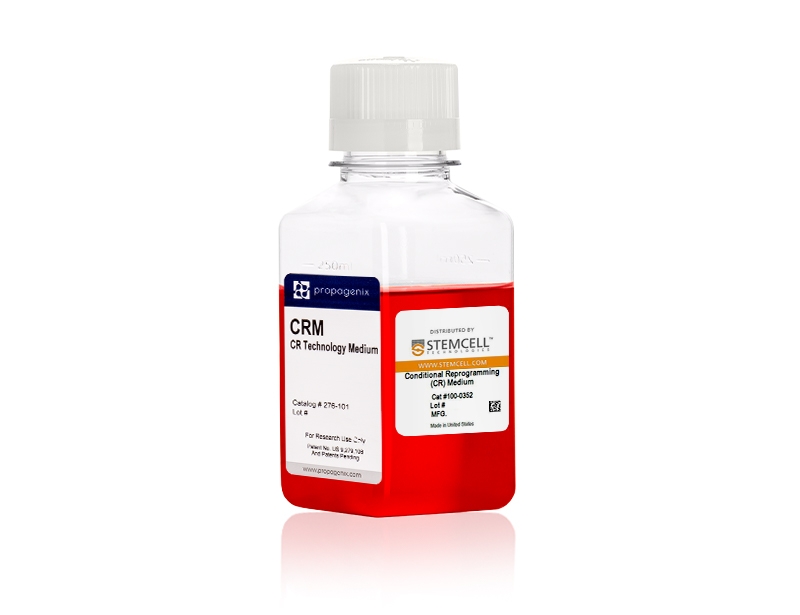Conditional Reprogramming (CR) Medium
Conditional reprogramming medium for epithelial cell expansion
概要
Conditional Reprogramming (CR) Medium is optimized to use with 3T3-J2 Irradiated Feeder Cells (Catalog #100-0353) to expand epithelial cells without genetic modification. Mature epithelial cells have been shown to restore tissue-specific progenitor phenotype that enables proliferation in the presence of CR Medium (Liu X et al. 2012; Liu X et al. 2017). This conditional proliferative capability is deactivated once the medium is removed from the cells (Liu X et al. 2012; Liu X et al. 2017). CR Medium is suitable to propagate primary epithelial cells from healthy or tumor tissues (airway, retina, prostate, breast, intestine, pancreas, liver biliary duct, etc.; Liu X et al. 2012; Liu X et al. 2017; Suprynowicz FA et al.). This product is free of antibiotics and intended for Research Use Only. CR Medium must be supplemented with cholera toxin prior to use.
Cell Type
Epithelial Cells, Mammary Cells, Prostate Cells
Species
Human
Application
Cell Culture, Differentiation, Expansion
Area of Interest
Epithelial Cell Biology, Stem Cell Biology
技术资料
| Document Type | 产品名称 | Catalog # | Lot # | 语言 |
|---|---|---|---|---|
| Product Information Sheet | Conditional Reprogramming (CR) Medium | 100-0352 | All | English |
| Safety Data Sheet | Conditional Reprogramming (CR) Medium | 100-0352 | All | English |
数据及文献
Publications (8)
Scientific Reports 2018
Patient-derived conditionally reprogrammed cells maintain intra-tumor genetic heterogeneity
Abstract
Abstract
Preclinical in vitro models provide an essential tool to study cancer cell biology as well as aid in translational research, including drug target identification and drug discovery efforts. For any model to be clinically relevant, it needs to recapitulate the biology and cell heterogeneity of the primary tumor. We recently developed and described a conditional reprogramming (CR) cell technology that addresses many of these needs and avoids the deficiencies of most current cancer cell lines, which are usually clonal in origin. Here, we used the CR cell method to generate a collection of patient-derived cell cultures from non-small cell lung cancers (NSCLC). Whole exome sequencing and copy number variations are used for the first time to address the capability of CR cells to keep their tumor-derived heterogeneity. Our results indicated that these primary cultures largely maintained the molecular characteristics of the original tumors. Using a mutant-allele tumor heterogeneity (MATH) score, we showed that CR cells are able to keep and maintain most of the intra-tumoral heterogeneity, suggesting oligoclonality of these cultures. CR cultures therefore represent a pre-clinical lung cancer model for future basic and translational studies.
Oncogene 2018
A system for detecting high impact-low frequency mutations in primary tumors and metastases
Abstract
Abstract
Tumor complexity and intratumor heterogeneity contribute to subclonal diversity. Despite advances in next-generation sequencing (NGS) and bioinformatics, detecting rare mutations in primary tumors and metastases contributing to subclonal diversity is a challenge for precision genomics. Here, in order to identify rare mutations, we adapted a recently described epithelial reprograming assay for short-term propagation of epithelial cells from primary and metastatic tumors. Using this approach, we expanded minor clones and obtained epithelial cell-specific DNA/RNA for quantitative NGS analysis. Comparative Ampliseq Comprehensive Cancer Panel sequence analyses were performed on DNA from unprocessed breast tumor and tumor cells propagated from the same tumor. We identified previously uncharacterized mutations present only in the cultured tumor cells, a subset of which has been reported in brain metastatic but not primary breast tumors. In addition, whole-genome sequencing identified mutations enriched in liver metastases of various cancers, including Notch pathway mutations/chromosomal inversions in 5/5 liver metastases, irrespective of cancer types. Mutations/rearrangements in FHIT, involved in purine metabolism, were detected in 4/5 liver metastases, and the same four liver metastases shared mutations in 32 genes, including mutations of different HLA-DR family members affecting OX40 signaling pathway, which could impact the immune response to metastatic cells. Pathway analyses of all mutated genes in liver metastases showed aberrant tumor necrosis factor and transforming growth factor signaling in metastatic cells. Epigenetic regulators including KMT2C/MLL3 and ARID1B, which are mutated in {\textgreater}50{\%} of hepatocellular carcinomas, were also mutated in liver metastases. Thus, irrespective of cancer types, organ-specific metastases may share common genomic aberrations. Since recent studies show independent evolution of primary tumors and metastases and in most cases mutation burden is higher in metastases than primary tumors, the method described here may allow early detection of subclonal somatic alterations associated with metastatic progression and potentially identify therapeutically actionable, metastasis-specific genomic aberrations.
Science 2018
Patient-derived organoids model treatment response of metastatic gastrointestinal cancers
Abstract
Abstract
Patient-derived organoids (PDOs) have recently emerged as robust preclinical models; however, their potential to predict clinical outcomes in patients has remained unclear. We report on a living biobank of PDOs from metastatic, heavily pretreated colorectal and gastroesophageal cancer patients recruited in phase 1/2 clinical trials. Phenotypic and genotypic profiling of PDOs showed a high degree of similarity to the original patient tumors. Molecular profiling of tumor organoids was matched to drug-screening results, suggesting that PDOs could complement existing approaches in defining cancer vulnerabilities and improving treatment responses.We compared responses to anticancer agents ex vivo in organoids and PDO-based orthotopic mouse tumor xenograft models with the responses of the patients in clinical trials. Our data suggest that PDOs can recapitulate patient responses in the clinic and could be implemented in personalized medicine programs.
Oncotarget 2017
Conditionally reprogrammed normal and primary tumor prostate epithelial cells: A novel patient-derived cell model for studies of human prostate cancer
Abstract
Abstract
Our previous study demonstrated that conditional reprogramming (CR) allows the establishment of patient-derived normal and tumor epithelial cell cultures from a variety of tissue types including breast, lung, colon and prostate. Using CR, we have established matched normal and tumor cultures, GUMC-29 and GUMC-30 respectively, from a patient's prostatectomy specimen. These CR cells proliferate indefinitely in vitro and retain stable karyotypes. Most importantly, only tumor-derived CR cells (GUMC-30) produced tumors in xenografted SCID mice, demonstrating maintenance of the critical tumor phenotype. Characterization of cells with DNA fingerprinting demonstrated identical patterns in normal and tumor CR cells as well as in xenografted tumors. By flow cytometry, both normal and tumor CR cells expressed basal, luminal, and stem cell markers, with the majority of the normal and tumor CR cells expressing prostate basal cell markers, CD44 and Trop2, as well as luminal marker, CD13, suggesting a transit-amplifying phenotype. Consistent with this phenotype, real time RT-PCR analyses demonstrated that CR cells predominantly expressed high levels of basal cell markers (KRT5, KRT14 and p63), and low levels of luminal markers. When the CR tumor cells were injected into SCID mice, the expression of luminal markers (AR, NKX3.1) increased significantly, while basal cell markers dramatically decreased. These data suggest that CR cells maintain high levels of proliferation and low levels of differentiation in the presence of feeder cells and ROCK inhibitor, but undergo differentiation once injected into SCID mice. Genomic analyses, including SNP and INDEL, identified genes mutated in tumor cells, including components of apoptosis, cell attachment, and hypoxia pathways. The use of matched patient-derived cells provides a unique in vitro model for studies of early prostate cancer.
American Journal of Respiratory Cell and Molecular Biology 2017
Pharmacological rescue of conditionally reprogrammed cystic fibrosis bronchial epithelial cells
Abstract
Abstract
Well-differentiated primary human bronchial epithelial (HBE) cell cultures are vital for cystic fibrosis (CF) research, particularly for the development of cystic fibrosis transmembrane conductance regulator (CFTR) modulator drugs. Culturing of epithelial cells with irradiated 3T3 fibroblast feeder cells plus the RhoA kinase inhibitor Y-27632 (Y), termed conditionally reprogrammed cell (CRC) technology, enhances cell growth and lifespan while preserving cell-of-origin functionality. We initially determined the electrophysiological and morphological characteristics of conventional versus CRC-expanded non-CF HBE cells. On the basis of these findings, we then created six CF cell CRC populations, three from sequentially obtained CF lungs and three from F508 del homozygous donors previously obtained and cryopreserved using conventional culture methods. Growth curves were plotted, and cells were subcultured, without irradiated feeders plus Y, into air-liquid interface conditions in nonproprietary and proprietary Ultroser G-containing media and were allowed to differentiate. Ussing chamber studies were performed after treatment of F508 del homozygous CF cells with the CFTR modulator VX-809. Bronchial epithelial cells grew exponentially in feeders plus Y, dramatically surpassing the numbers of conventionally grown cells. Passage 5 and 10 CRC HBE cells formed confluent mucociliary air-liquid interface cultures. There were differences in cell morphology and current magnitude as a function of extended passage, but the effect of VX-809 in increasing CFTR function was significant in CRC-expanded F508 del HBE cells. Thus, CRC technology expands the supply of functional primary CF HBE cells for testing CFTR modulators in Ussing chambers.
Cell Reports 2017
Primary Patient-Derived Cancer Cells and Their Potential for Personalized Cancer Patient Care
Abstract
Abstract
Personalized cancer therapy is based on a patient's tumor lineage, histopathology, expression analyses, and/or tumor DNA or RNA analysis. Here, we aim to develop an in vitro functional assay of a patient's living cancer cells that could complement these approaches. We present methods for developing cell cultures from tumor biopsies and identify the types of samples and culture conditions associated with higher efficiency of model establishment. Toward the application of patient-derived cell cultures for personalized care, we established an immunofluorescence-based functional assay that quantifies cancer cell responses to targeted therapy in mixed cell cultures. Assaying patient-derived lung cancer cultures with this method showed promise in modeling patient response for diagnostic use. This platform should allow for the development of co-clinical trial studies to prospectively test the value of drug profiling on tumor-biopsy-derived cultures to direct patient care. Kodack et al. report on the development of cancer models from tumor biopsies and technologies toward a functional approach for personalized medicine. They describe the ability to reliably test drug response in patient-derived samples of mixed cell populations. In doing so, they show that patient biopsy cultures may predict patient clinical responses.


